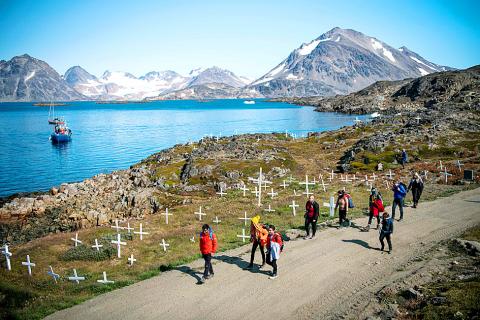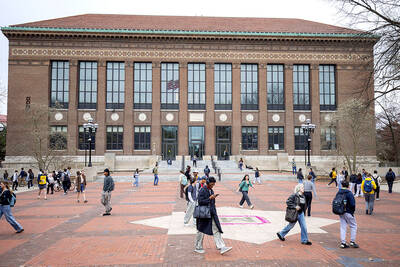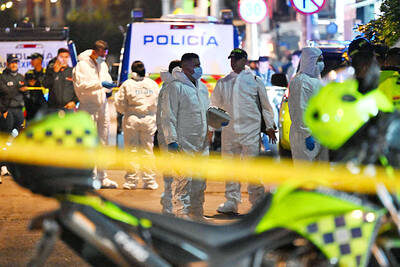Kayaking past blue-white icebergs drifting along near a pristine harbor, wandering around colorful houses or trekking in the snow-capped wilderness: July and August are high season for tourists in eastern Greenland.
Many of the 85,000 tourists who visit each year head to the west coast, but eastern Greenland, with its glaciers, wilderness and wildlife starring whales and polar bears, is also drawing visitors.
Sarah Bovet, a 29-year-old Swiss artist, said it is difficult to know what to expect.

Photo: AFP
“Thinking you’re going to be surprised, you are even more so in reality,” she said, standing outside a hostel in the tiny village of Kulusuk.
Bovet was on an artistic residency in Greenland when she visited the island of Kulusuk and its 250 souls.
Although she had imagined a small village before arriving, its stunning views and bright colors still came as a surprise.
With just one supermarket, an airport built in the 1950s by the US military to serve a Cold War radar base, and a harbor surrounded by brightly painted wooden houses, most of the villagers appreciate the extra revenue from tourism.
Justus Atuaq, a young hunter in Kulusuk, takes tourists out on sled tours in March and April — the spring high season — earning money that helps him feed and care for the dogs he uses for racing and hunting.
“Now I can take dogsleds for hunting and sometimes tourists coming from other countries also want to dogsled,” Atuaq said outside his wooden house.
Tourists also take boat trips during the summer high season in July and August.
Arrivals to the island grew 10 percent year-on-year from 2014 to 2017, and 3 percent last year, according to the tourist board, Visit Greenland.
Many adventure seekers and nature lovers arrive by plane, but cruise ships also bring admirers, hugging the picture-perfect coastline.
However, they are not alone in taking an interest in the world’s largest island.
The Danish territory’s natural resources and strategic importance as the Arctic ice sheet melts have attracted the attention of US President Donald Trump.
The Arctic region has untapped reserves of oil, gas and minerals, as well as abundant stocks of fish and shrimp.
In August, Trump offered to buy Greenland, then called off a visit to Copenhagen over its refusal to sell.
Denmark colonized Greenland in the 1700s, granting it autonomy in 1979.
Today, many Greenlandic political parties advocate full independence.
The territory still receives an annual subsidy from Copenhagen, which was 4.3 billion kroner (US$637.5 million) in 2017, and tourism could help it to become economically self-reliant.
Like many parts of Greenland, Kulusuk has no tarmac roads and visitors must travel by plane or boat.
The growth in tourism could put a strain on the village’s infrastructure, and the sector faces unique challenges given Greenland’s location, weather and the cost of traveling there.
Day tours of Kulusuk with flights from the Icelandic capital, Reykjavik, are 97,000 Icelandic kronur (US$777).
Jakob Ipsen, a 48-year-old who grew up between Denmark and Greenland’s west coast, runs Kulusuk’s sole hotel.
The 32-room facility stands beside a fjord and from its dining room, people can watch icebergs drift by in the summer.
However, the region’s isolation can be problematic, Ipsen said.
“We have to get all our supplies in with the first ship for the whole summer season, and for the winter season, when everything is frozen over, we have to get all our supplies in with the last ship for the whole winter,” he said.
Greenland must tackle its infrastructure challenges if it wants to develop tourism, Visit Greenland said.
Government-funded work is under way to extend runways at the capital, Nuuk, and Ilulissat, both on the west coast, and a new airport is planned in the south.
The tourist body said it would weigh the impact of boosting infrastructure on the environment and on local communities.
Ipsen worries about the effects of uncontrolled tourism to the region.
“We want to try to maintain it as it is, so it’s not exploding,” he said.
Already the rise in visitor numbers is making itself felt, said Johanna Bjork Sveinbjornsdottir, who runs tours in Kulusuk for an Iceland-based company.
“In the campsites here out in nature where you used to be alone, there’s two, three groups at a time,” Sveinbjornsdottir said.
Like Ipsen, she is also concerned about the effect that rising visitor numbers could have on the wilderness around the village.
“If you want nature to survive that, you have to build up the infrastructure,” she said, pointing to the lack of officially designated campsites around Kulusuk, with no trash cans or toilets for travelers outdoors and no one supervising the sites.
Despite the concerns, Sveinbjornsdottir hopes visitors will keep coming.
“They go back as different people,” she said. “Everything is beyond what you ever imagined.”

Swedish campaigner Greta Thunberg was deported from Israel yesterday, the Israeli Ministry of Foreign Affairs said, the day after the Israeli navy prevented her and a group of fellow pro-Palestinian activists from sailing to Gaza. Thunberg, 22, was put on a flight to France, the ministry said, adding that she would travel on to Sweden from there. Three other people who had been aboard the charity vessel also agreed to immediate repatriation. Eight other crew members are contesting their deportation order, Israeli rights group Adalah, which advised them, said in a statement. They are being held at a detention center ahead of a

A Chinese scientist was arrested while arriving in the US at Detroit airport, the second case in days involving the alleged smuggling of biological material, authorities said on Monday. The scientist is accused of shipping biological material months ago to staff at a laboratory at the University of Michigan. The FBI, in a court filing, described it as material related to certain worms and requires a government permit. “The guidelines for importing biological materials into the US for research purposes are stringent, but clear, and actions like this undermine the legitimate work of other visiting scholars,” said John Nowak, who leads field

‘THE RED LINE’: Colombian President Gustavo Petro promised a thorough probe into the attack on the senator, who had announced his presidential bid in March Colombian Senator Miguel Uribe Turbay, a possible candidate in the country’s presidential election next year, was shot and wounded at a campaign rally in Bogota on Saturday, authorities said. His conservative Democratic Center party released a statement calling it “an unacceptable act of violence.” The attack took place in a park in the Fontibon neighborhood when armed assailants shot him from behind, said the right-wing Democratic Center, which was the party of former Colombian president Alvaro Uribe. The men are not related. Images circulating on social media showed Uribe Turbay, 39, covered in blood being held by several people. The Santa Fe Foundation

NUCLEAR WARNING: Elites are carelessly fomenting fear and tensions between nuclear powers, perhaps because they have access to shelters, Tulsi Gabbard said After a trip to Hiroshima, US Director of National Intelligence Tulsi Gabbard on Tuesday warned that “warmongers” were pushing the world to the brink of nuclear war. Gabbard did not specify her concerns. Gabbard posted on social media a video of grisly footage from the world’s first nuclear attack and of her staring reflectively at the Hiroshima Peace Memorial. On Aug. 6, 1945, the US obliterated Hiroshima, killing 140,000 people in the explosion and by the end of the year from the uranium bomb’s effects. Three days later, a US plane dropped a plutonium bomb on Nagasaki, leaving abut 74,000 people dead by the